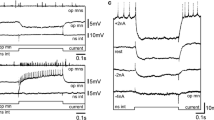Summary
-
1.
The patterns of spiking in supralateral radular retractor motoneurones ofPlanorbarius are examined. Collectively, the four pairs of identified neurones spike during much of each feeding cycle, though only two discharge during retraction itself. Spiking in the remainder is concerned with radular tensing which is important during rasping, but which is especially evident in the newly distinguished, withdrawn phase; they are inhibited during retraction.
-
2.
By recording from up to four motoneurones simultaneously, it has been established that common EPSPs and IPSPs, and a number of specific inputs ensure a precise phasing of bursting in these cells.
-
3.
The frequent occurrence of prolonged tonic barrages of IPSPs in non-feeding preparations suggests the presence of spontaneously active, premotor elements. This same input displays cyclical activity coincident with rhythmic feeding movements of the buccal mass, and evidence indicates that it is the result of activity in four premotor sources, two ipsi- and two contralateral.
-
4.
Spiking in the pool of buccal ‘trigger’ neurones converts this tonic activity into patterned cyclical input, and can result in spiking in the retractor motoneurones. The ‘trigger’ neurones themselves make few direct connections with the retractor population.
-
5.
Feedback evoked by contractions of the supralateral radular retractor muscles in non-feeding preparations regulates activity in the retractor motoneurones. Proprioceptive inputs appear (1) to modulate the cycling of the pattern generator, and thus of rhythmic behaviour in the retractor motoneurones, and (2) to provide excitatory feedback within each feeding cycle.
Similar content being viewed by others
References
Audesirk TE, Audesirk GJ (1979) Oral mechanoreceptors inTritonia diomedea. II. Role in feeding. J Comp Physiol 130:79–86
Benjamin PR, Rose RM (1979) Central generation of bursting in the feeding system of the snail,Lymnaea stagnalis. J Exp Biol 80:93–118
Benjamin PR, Rose RM, Slade CT, Lacy MG (1979) Morphology of identified neurones in the buccal ganglia ofLymnaea stagnalis. J Exp Biol 80:119–135
Berry MS (1972a) A system of electrically coupled small cells in the buccal ganglion of the pond snailPlanorbis corneus. J Exp Biol 56:621–637
Berry MS (1972b) Electrotonic coupling between identified large cells in the buccal ganglia ofPlanorbis corneus. J Exp Biol 57:173–185
Berry MS, Pentreath VW (1976) Criteria for distinguishing between monosynaptic and polysynaptic transmission. Brain Res 105:1–20
Brace RC, Quicke DLJ (1980) Neural control of radular retractor muscles of the pulmonate snail.Planorbarius corneus (L.): Functional anatomy and properties of neuromuscular units. J Exp Biol 86:115–133
Bulloch AGM, Dorsett DA (1979) The functional morphology and innervation of the buccal mass ofTritonia hombergi. J Exp Biol 79:7–22
Burrows M (1975) Monosynaptic connections between wing stretch receptors and flight motoneurones of the locust. J Exp Biol 62:189–219
Carriker MR (1946) Observations on the functioning of the alimentary system of the pond snailLymnaea stagnalis Say. Biol Bull 81:88–111
Crampton DM (1973) The functional anatomy of the buccal mass of one opisthobranch and three pulmonate gastropod molluscs. PhD thesis, University of Reading
Davis WJ, Siegler MVS, Mpitsos GJ (1973) Distributed neuronal oscillators and efference copy in the feeding system ofPleurobranchaea. J Neurophysiol 36:258–274
Getting PA (1974) Modification of neuron properties by electronic synapses. I. Input resistance, time constant and integration. J Neurophysiol 37:846–587
Getting PA, Willows AOD (1974) Modification of neuron properties by electronic synapses. II. Burst formation by electronic synapses. J Neurophysiol 37:858–868
Goldschmeding JT (1977) Motor control of eating cycles in the freshwater snailLymnaea stagnalis. Proc K Ned Akad Wet C 80:171–189
Graham A (1955) Molluscan diets. Proc Malacol Soc (Lond) 31:144–157
Grillner S (1975) Locomotion in vertebrates: Central mechanisms and reflex interaction. Physiol Rev 55:247–314
Hembrow D (1973) Observations on the structure and function of the buccal mass ofPlanorbarius corneus (L.). Proc Malacol Soc (Lond) 40:492–505
Hubendick B (1957) The eating function inLymnaea stagnalis (L.). Arch Zool 10:511–521
Kaneko CRS, Merickel M, Kater SB (1978) Centrally programmed feeding inHelisoma: Identification and characteristics of an electrically coupled pre-motor network. Brain Res 140:1–21
Kater SB (1974) Feeding inHelisoma trivolvis: The morphological and physiological bases of a fixed action pattern. Am Zool 14:1017–1036
Kater SB, Rowell CHF (1973) Integration of sensory and centrally programmed components in generation of cyclical feeding activity inHelisoma trivolvis. J Neurophysiol 36:142–155
Merickel MB, Kater SB, Eymann ED (1978) Burst generation by an electrically coupled network in the snailHelisoma: Analysis using computor simulation. Brain Res 159:331–349
Pearson KG, Fourtner CR, Wong RK (1973) Nervous control of walking in the cockroach. In: Stein RB, Pearson KG, Smith RS, Redford JB (eds) Control of posture and locomotion. Plenum Press New York, pp 495–514
Rose RM, Benjamin PR (1979) The relationship of the central motor pattern to the feeding cycle ofLymnaea stagnalis. J Exp Biol 80:137–163
Shik ML, Orlovsky GN (1978) Neurophysiology of locomotor automatism. Physiol Rev 56:465–501
Siegler MVS (1977) Motor neurone co-ordination and sensory modulation in the feeding system of the molluscPleurobranchaea californica. J Exp Biol 71:27–48
Siegler MVS, Mpitsos GJ, Davis WJ (1974) Motor organisation and generation of rhythmic feeding output in the buccal ganglion ofPleurobranchaea. J Neurophysiol 37:1173–1196
Stein RB (1974) Peripheral control of movement. Physiol Rev 54:215–243
Woollacott MH (1974) Patterned neural activity associated with prey capture inNavanax (Gastropoda, Aplysiacea). J Comp Physiol 94:69–84
Author information
Authors and Affiliations
Additional information
D.L.J. Quicke was supported by an SRC studentship. We wish to thank Professor P.N.R. Usherwood for criticizing a preliminary draft of the manuscript, and Dr. R.L. Ramsey for technical assistance.
Rights and permissions
About this article
Cite this article
Brace, R.C., Quicke, D.L.J. Activity patterns in radular retractor motoneurones of the snail,Planorbarius . J. Comp. Physiol. 142, 259–270 (1981). https://doi.org/10.1007/BF00605744
Accepted:
Issue Date:
DOI: https://doi.org/10.1007/BF00605744




